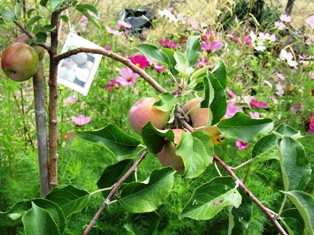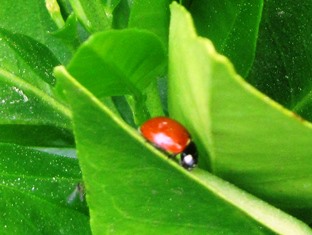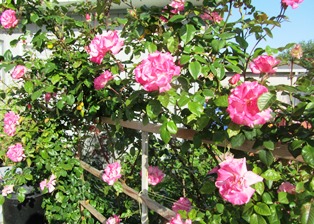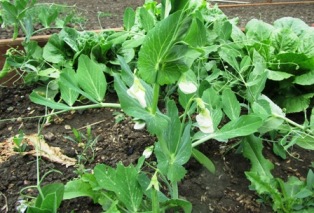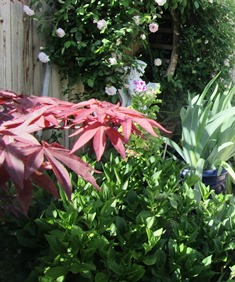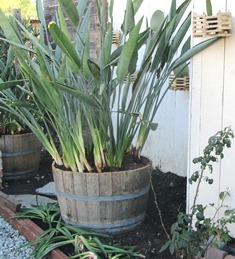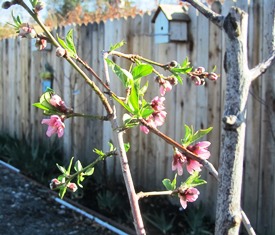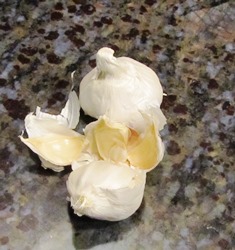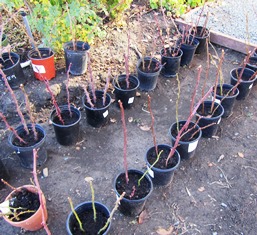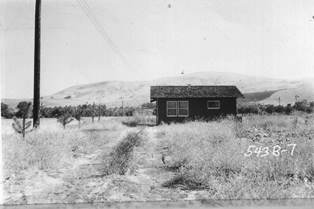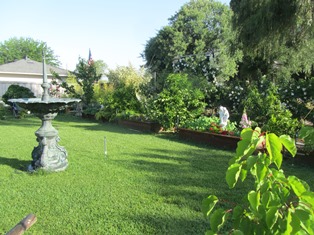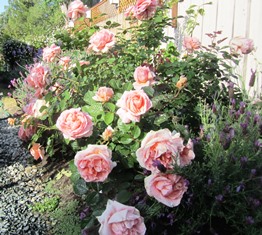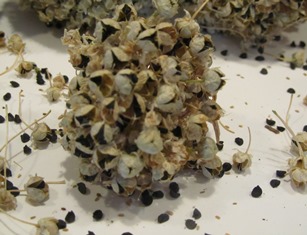Archive for the 'Gardening' Category
Rooting Plants in Water
I’m a compulsive clipper of plants, knowing that many will send out new roots if placed in a container of water on a window sill. It’s not uncommon for my window sill to fill up with glass jars of cuttings.
With my precious clippings in water, I change the water often to keep it from becoming stagnant.
Among the plants that easily root in water are begonia, coleus, English ivy, geranium, grape ivy, philodendron, pothos, African violet, avocado, and sweet potato.
Several varieties of herbs also root in water: basil, catnip, various kinds of mint, pineapple sage, and watercress.
Bulbs, such as paperwhite narcissus, amaryllis, and hyacinth can be forced to bloom and will also produce roots. Place the base of the bulb on stones or marbles in a dish with water so that the bulb’s base sits on the water’s surface. The roots will grow downward, so you must always ensure there is adequate water.
Take care when putting your cuttings into soil so as not to damage the fragile, newly formed roots. Once you see how easy the process is, you might find your window sill filling up with cuttings in water, too.
California’s Farmers Markets Offer Fresh and Tantalizing Fruits and Berries
Eating fresh means growing it yourself or purchasing the food for your table direct from its source. California farmers’ markets offer a dazzling variety of fruits, vegetables, and nuts directly from local area farmettes, orchards, small and commercial farms, specialty growers, and ranchers.
Many fruits and vegetables are certified organic. That means the farmers and growers are registered and in compliance with state and local regulations designed to protect consumers and ensure food quality and safety.
Annually, California produces nearly half of the nation’s fruits, nuts, and vegetables, according to the California Department of Food and Agriculture. See http://www.cdfa.ca.gov/Statistics/
The San Joaquin Valley of central California has earned the moniker of the World’s Food Basket since its crops account for 12.8 percent of all agricultural products from California.
In fact, California leads the nation in production of figs, dates, plums, melons, nectarines, peaches (Clingstone and Freestone), pears (Bartlett), persimmons, raspberries, and apricots.
In the Golden State, you can find dozens of types of fruits offered at 350 farmers’ markets (some open all year long). For a list by county, see http://www.pcfma.com/markets.php.
From the Pacific Coast Farmer’s Market Association, the following list (recapped below) reveals when these fruits are in season in California.
Apples: January-February; August-December
Apricots: May-July
Blackberries: June-September
Blueberries: May-August
Boysenberries: June-August
Cantaloupe: May-September
Cherries: April-June
Citrus: January-March; November-December
Dates: September-December
Figs: September-November
Grapes: August-November
Kiwi: January-April; October-December
Melons: June-September
Nectarines:May-September
Peaches: May-September
Pears: September-December
Persimmons: September-November
Plums: May-October
Pluots: May-September
Pomegranates: September-November
Prunes: May-September
Raspberries: May-October
Strawberries: February-November
Watermelon: July-September
The Benefits of Bamboo

Bamboo plants make great screens, clipped hedges, or a dramatic foil for plants layered in front of it.
Bamboo plants are favored by environmentalists because they are drought tolerant, can be used for erosion control, are not fussy about soil, make fast-growing hedges or screens, and quickly naturalize.
We grow mainly the clumping type of bamboo because it makes very little horizontal growth and stays tightly clumped. It just gets dense.
The runner type, however, spreads through underground stems that grow out from the rhizome. These are the types of bamboos that reach considerable heights and form groves.
Dividing the plants helps maintain control of these woody-stemmed giant grasses.
Spring is the best time to divide bamboo plants. Although spring is still a few days away, we are dividing the bamboo that thrives along our farmette fences and planting it as a screen on the side of the house where we can see traffic from the road.
Although bamboo has gotten a bad rap for spreading into areas where it isn’t wanted, it can be confined in containers or by inserting metal or concrete barriers into the soil to prevent unwanted invasion by the runner type.
The plant’s evergreen leaves on tall, slender stems look graceful swaying in the breeze and, coupled with its other benefits, make bamboo a good choice for some landscapes.
Have You Planned Your Garden Yet?
Ladybugs and honeybees occasionally meet on the same leaf when both forage for food. The ladybugs dine on aphids while the honeybees seek the sweet nectar of blossoms; orange, tangerine, and lime trees are favorites.
The bug and bee traffic has been steadily increasing now that showers and warm weather have triggered blossoms opening on the fruit and citrus trees around the farmette.
Spring doesn’t officially begin until March 20, but with the weather forecasters predicting upper 70’s Fahrenheit later this week and nighttime temperatures in the 50’s, it is time to consider options for your garden. Many DIY centers are already offering vegetable seedlings, herbs, and berries for planting. Some have markedly discounted their bare-root fruit trees and roses.
I’ve already planted seeds in flats for germination and scattered flower seed (collected from last summer’s flower garden) around prepared beds. When the outside temperatures start to climb, I’ll be rewarded with blooms from nasturtiums, petunias, zinnias, and sunflowers.
The climbing roses are already past the red-leaf stage and are producing the first flush of blooms for spring. The wisteria vines have plump pods ready to unfurl with gorgeous tracts of purple blossoms. And the first green tips of leaves are beginning to sprout on my apples even as the early peaches and apricots already have fruit forming.
This time of year holds the promise of new beginnings, and you see that in every step you take in a garden. Because I prefer to grow plants from varieties of heirloom, open-pollinated seed, I save it from the best specimens grown in the previous season. Of course, some plants freely re-seed themselves. That’s why I now find lettuce and onions and even sweet peas coming up in expected places on the property.
Have you figured out what veggies, flowers, fruits, and berries you’ll plant and grow in your garden this year? If not, now’s a good time to get started. For ideas, check out, http://www.organicgardening.com/learn-and-grow/plan-beautiful-vegetable-garden.
If you prefer, as I do, the non-GMO and organic seeds, there are many excellent sources for them. For heirloom and rare seed, check out http://www.rareseeds.com/store/vegetables/. Also see, http://www.victoryseeds.com/aboutus.html and http://www.anniesheirloomseeds.com/
Telltale Signs of Spring
As I write this, the honeybees are scouting every plant on the property. Awakened by warm weather and sunlight, they search for nectar. Aside from a few California poppies and other wildflowers blooming in front of the house, they won’t find much to forage on just yet.
Of course, there are a few apricot, nectarine, and almond tree blossoms as well as a smattering of white strawberry blooms in the raised beds at the back of our property. But within a few weeks, the warm weather of March and April will render the farmette virtually covered in masses of sweet offerings for the honeybees.
Still, there are the early signs of spring. The Japanese maples are leafing out in a dazzling show of red color. The pregnant stems of our bearded iris are swelling now for their Easter bloom cycle. And the Greek oregano is popping up everywhere as it does this time of year.
Birds are building nests, but I haven’t seen the red-breasted robins just yet. When they show up, searching for worms and grubs, I will know spring has truly arrived. Until then, I look for the telltale signs that Mother Nature is about to robe herself in the splendid garments of spring–fruit tree blossoms, leaves, blooming wildflowers, and lovely kitchen herbs pushing up all over the place.
Tell the Plants to Go Back to Sleep . . . It’s Still Winter
It’s beach weather along Northern California’s coastline and bare root season technically won’t start for another few weeks. It’s the last Saturday in January–still winter. But the plants are waking up all around Henny Penny Farmette, thanks to the record-breaking, unseasonably warm weather.

Narcissus are grown from bulbs and when massed together in plantings return year after year in a cheerful splash of color
The narcissus seem to have popped up overnight. We tucked three dozen bulbs in a bed the first fall we lived on the farmette. The next spring, they bloomed. Their tall stalks and leaves die during summer, but every spring they emerge to bloom again, creating a dramatic drift of color.
Who doesn’t love working in shirt sleeves? But our gardens need rain and we need the plants to remain dormant while we finish winter chores and get our new chicken house ready.
This week, we finished dividing the strawberries and irises, cutting back the roses, and spraying the fruit trees again.We created another sitting area in the garden under a large apricot tree, laid a gravel floor, and planted Bird of Paradise (Strelitzia reginae) plants in half barrels.
Bird of Paradise plants (also known as crane flower) are indigenous to South Africa. The plants are heat lovers and aren’t too fussy about soil. Planting them in containers is a good idea if you live in an area, as we do, where the winter temperatures fall below 50 degrees Fahrenheit. You simply move them indoors.
The Bird of Paradise foliage makes a nice foil for the plant’s striking blooms of orange, fuchsia, and purple that resemble a crane’s head and beak.
I think it’s too late to tell the plants to go back to sleep. So even if it’s torture to spend a long, languorous day digging in my garden in my shirt sleeves, while the rest of the country is freezing, I suppose I simply must soldier on.
What’s Not to Like about Garlic?
The use of garlic (Allium sativum, an herb) was well known in the ancient world as a flavoring agent for food as well as a powerful medicinal aid. In fact, the ancients believed garlic was especially beneficial in the treatment of such maladies as indigestion, respiratory ailments, parasitic infections, and fatigue.
Modern scientific studies have shown garlic to be an effective agent in reducing blood pressure and high cholesterol. People have also used it in the treatment of tuberculosis, bronchitis, dysentery, liver ailments, diabetes, and rheumatism. Some believe garlic slows the progression of artherosclerosis (hardening of the arteries). Garlic can work like a blood thinner, and thus, it might be a valuable agent in preventing strokes and heart attacks.
Emory University School of Medicine researchers discovered that Diallyl trisulfide found in garlic oil helps to protect the heart during cardiac surgery and after a heart attack. The compound also seems to have cancer fighting properties.
Garlic kills cancer cells in test tubes. It may also lower the risk of developing colon cancer. See, http://umm.edu/health/medical/altmed/herb/garlic
A research study in China used anecdotal evidence to support the belief that eating raw garlic more than twice a week can lower the risk of getting lung cancer by 44 percent. The research was published in the journal Cancer Prevention Research.
Garlic is rich in antioxidants. Garlic oil, according to research published in the Journal of Agriculture and Food Chemistry, potentially could be used to prevent diabetes-induced cardiomyopathy, although the researchers say further study is needed. Diabetics are at higher risk for developing cardiomyopathy, a thickening of the myocardium that makes the heart become enlarged over time and less effective as a pump.
Long valued as an anti-inflammatory agent, garlic also strengthens the immune system. When taken as a prophylactic, garlic is believed to reduce the number of colds people get during the cold and flu season.
I am not a medical doctor but I believe eating a wide variety of herbs, vegetables, fruits, grains, and nuts for their nutritional value. Of course, the closer the food is to being organic and fresh, the better it will be for the body.
Garlic is easy to grow. It needs full sun, good drainage, and rich, loamy soil. In the fall, plant the cloves two inches under the soil and six inches apart clove pointed upward. Water weekly.
The cloves will grow in the spring and are ready to harvest around mid June to July, when roughly 3/4 of the top growth has turned yellow. Hang four to six weeks to cure. Keep a braid of garlic in kitchen for use in your culinary creations.
Preparing for an Early Spring
It’s winter. The nights are cold and the early mornings even colder. But here on the farmette, daytime temps are still unseasonably warm for this time of year in Northern California. That makes doing all the winter cleanup and spring preparation chores not only tolerable, but enjoyable.
We’ve pruned all the roses and taken cuttings for propagation of new bushes that we’ll plant around our property. We’ve divided the irises and planted the babies in new beds. Finally, we tackled pruning the fruit trees and imagine how shocked we were to find our Desert Gold peach trees with buds ready to open. The reason must be the warm weather.
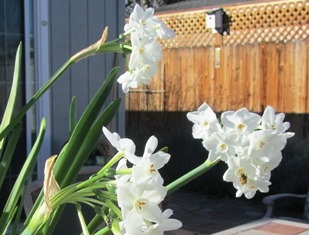
The honeybees are searching for blossoms and finding none, they’re exploring the papaperwhite narcissus on my patio table
The honeybees are searching for flowers in bloom. They’ve flown to the citrus trees that I’ve covered against nighttime freezing temps and are wandering about on the blankets. The French perfume lavender still has some blooms but the bees seem also interested in the paperwhite narcissus blooms that I forced in water between Christmas and New Years Day.
We’ve moved the strawberries to a newly prepared bed in two planter boxes and are revitalizing the soil in the old boxes. Bare root season is around the corner and my husband and I are feeling the pressure to get the garden ready for a new growing season. The days are lengthening and we don’t want an early spring to catch us unprepared. Technically, winter has only just begun but the birds and bees and buds on the trees are suggesting it could be a short winter.
The Farmette Renovation Work Continues through All Seasons
I met with the tax assessor last month and he gave me a picture of our small farmette house from 1953. At that time, the house was only six months old. Over the ensuing years, many changes were made, rendering the tiny miner’s shack or bunkhouse (that appears to have been a single room) into a 2-bedroom, 2 bath house of roughly 1,000 square feet. We continue to renovate but limited resources slows everything. Eventually, we’ll have a small finished house in a lovely environment.
When we found the property in 2009, it was in foreclosure and looked like a dump. That’s because it had been used as one. Broken pieces of granite and cabinetry wood had been piled along its aging, rotting fences, too weak and weary to remain upright. Inside, the hardwood floors had been ripped off and everything that could be “harvested” from the house by others had been taken. The only appliance was an old refrigerator sitting a weed-field that served as the back yard.
But we saw land all around. Rising up to the north in back of our farmette are hills (emerald green in the rainy season) that separate the inland valley where our farmette is located from the great Central Valley of California. Seeming as near as our front yard, the blue-green peaks of Mount Diablo tower over the landscape in the east and southeast (we now see these from our living room couch and front porch). From the northwest in summer, the breezes off the San Francisco Bay where it becomes the Straits of Carquinez blow toward Mount Diablo around 4:00 P.M. every day to cool the area.
After pulling out the weeds that at one point towered over our heads, we envisioned re-engineering everything. We constructed a new landscape that included fruit, citrus, and nut trees, beds for roses and other flowers, an heirloom herb and vegetable garden, and a designated area for bees and chickens.
Without a huge budget, we believed the renovation of the house would be ongoing (and it has been). This is our fourth winter. When we are not working outside, we are working on the renovation inside. For example, recently we installed window trim in the living room. Today, I’ll caulk, spackle, and sand in preparation for painting later this week.
Previously the entry into the house was through a side door and bathroom. The first impression wasn’t good. My husband created a welcoming entrance with exterior moldings around the windows and door. I talked him into a screen door and a porch (as yet unfinished) with a trellis to support purple wisteria.
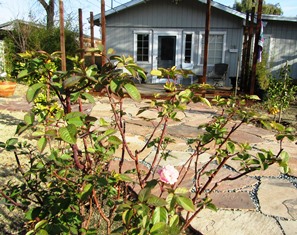
A flagstone path lined with roses and citrus trees leads to the new front door but the porch is yet to be finished
Since unseasonably warm temperatures have been forecast for the week, we have begun work on a flagstone walkway leading to the porch. I love when Carlos gets out string, stakes, and the can of marking spray and begins putting down boundaries for fences, walkways, stone paths, and garden gates. The tax assessor didn’t ask about those markings. But we expect the property value to be listed higher next year because of the renovation we’ve already done.
Salivating Over New Organics from Old and Rare Seed
What I love most about the onset of winter is the arrival of the seed catalogs. Armed with the newest one, I enjoy sitting on the porch, warming my bones under the pale winter sun, and reading about what I could be growing on the Henny Penny Farmette this spring–like the onions from rare, old seed that Bountiful Gardens offers in its 2014 catalog.
Bountiful Gardens is a nonprofit organization located in Willits, California (160 miles north of San Francisco). The organization has signed the Safe Seed Pledge and promises to never knowingly buy or sell seeds that are GMO (genetically modified).
The onion seed I’m eager to purchase is the Mill Creek Red Onion–a special heirloom I read about that is considered to be bolt-resistant and grows well in spring or fall. According to the catalog, the onion was bred by nursery owners Joe and Wanda Turi, who have since passed away. Thanks to the folks at Bountiful Gardens, a box of the Turi’s onions was acquired, ensuring the rare seed would be preserved and multiplied in gardens like mine and yours.
Another vegetable I want to try is the Early Purple Sprouting broccoli, a European heirloom that grows into a large plant with purple heads possessing excellent nutritional value and flavor. An August planting is recommended because the plant needs to survive through a winter to become productive.
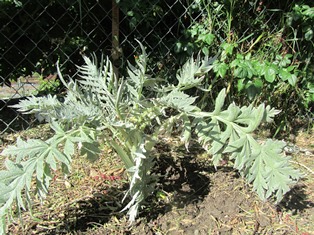
I managed not to kill the artichoke I planted last year and, thus encouraged, I would like to grow some other varieties
The artichoke (cynara cardynculus) listing in the catalog also intrigues me. The plant won’t produce chokes during its first year, but I don’t mind. Having an abundance of chokes for farmette meals makes me want to send for the seed right now. Don’t even get me started on all the herbs I want to order and plant! I might have to turn the farmette into a farm.
The Bountiful Gardens 2014 catalog is one of the best. Not only are the listings intriguing to read, the full-color pictures are nothing short of seductive for a gardener. Offerings include heirloom, open-pollinated, untreated seeds for sustainable growing of vegetables, grains, oil and forage crops, wild trees and shrubs, berries, herbs, and flower. The catalog even offers mushroom spawn. There are also books and media products available on gardening topics, composting, permaculture, self-sufficiency, garden pests, tools, seed saving, and much more.
If you are interested in getting your own copy of the 2014 catalog, write to Bountiful Gardens, 18001 Shafer Ranch Road, Willits, CA 95490; phone 707-459-6410. Or email: bountiful@sonic.net. See, http://www.bountifulgardens.org
 Facebook
Facebook Goodreads
Goodreads LinkedIn
LinkedIn Meera Lester
Meera Lester Twitter
Twitter





